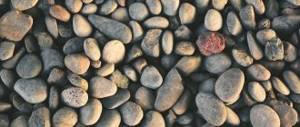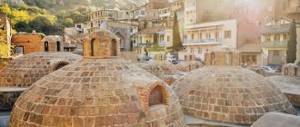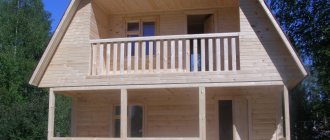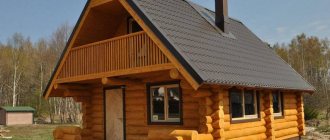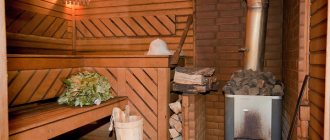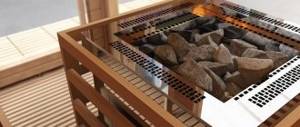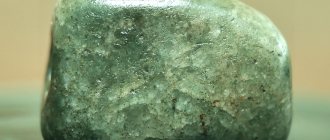Composition of dunite
Characteristics of dunite
Application
Properties
How to choose dunit for a bath
Dunite is a stone usually ranging in size from 5 to 15 cm, which is found deep in the mountains, it is usually used in baths. Dunite is also called peridotite, and in Finland - olivine. This is a rock whose deposits are found deep in volcanoes, so dunite can easily withstand temperatures of more than 1200 degrees Celsius. It can be used in baths without fear of cracking and the appearance of cracks. Dunite is a very environmentally friendly stone. This stone will not crack over time, allowing you to quickly and efficiently heat the steam room to the desired level. Peridotite does not contain harmful impurities and does not emit harmful odors when heated. In Rus', dunite has been considered the best stone for a steam room since ancient times.
Magnesium and chromium are present in large quantities in dunite. It has a light green color; sometimes there are rocks that are dark green, sometimes even gray or black. It has a very beautiful full-crystalline structure and texture with various specks of various colors. Due to this, the bathhouse will look very advantageous.
The main deposits of this stone are the Doon Mountains in New Zealand. Now found in large numbers in the mountains of the Urals and Central Asia. The structure is porous, fine-grained, and samples with medium grains are also found. The cost of the stone is not too high and varies from 20 to 55 rubles per 1 kilogram.
Rules for choosing a quality mineral
The most important characteristics that stones for baths and saunas should have include:
- uniformity;
- good heat capacity;
- strength;
- no toxic odors when heated;
- low level of water absorption.
Why do experts recommend purchasing certified and already packaged products, rather than collecting the first river stones you come across for a bath?
Acting this way without having experience and special knowledge of geology is very dangerous. Constant and significant temperature changes in the steam room can destroy even stone. And if you have collected unsuitable stones for the stove in the bathhouse, they can split when heated, shooting out fragments, which can lead to serious injuries.
But that’s not so bad. Many minerals emit toxic gases when heated, and stones of organic origin saturate the generated steam with harmful microelements. As a result, under no circumstances use stones for baths and saunas whose properties are unknown to you.
In addition to all of the above, the quality of steam is also influenced by the size and appearance of the stones. Pay extreme attention to the arrangement of the backfill itself.
A good heater on the stove:
- durable;
- heat-intensive;
- dense;
- resistant to temperature changes;
- the stones in it have optimal sizes.
For electric furnaces, you need to select medium-sized stones. For wood-burning analogues, choose a combination - medium and large backfill.
It is worth noting that all experts agree that the best types of stones for a steam room are volcanic. The logic here is simple - since they underwent the action of gigantic temperatures of the Earth’s magma during formation, then they will withstand bathing procedures calmly.
Let's take a closer look at the stones for the bath: which ones are best to purchase.
READ MORE: Ginnala maple: description, in landscape design, planting and care
When choosing stones for a bath, you should first study the information about what they should be. During the selection process, it is recommended to adhere to the following recommendations:
- the shape must be round and the surface smooth - all this contributes to good air circulation and heating;
- if the heater is small in size, then the selected rocks should be small;
- there should be no inclusions of other types of rock, mica and defects that will lead to rapid destruction;
- Before you start using stones, you need to first check them for cracks and chips.
As a test, it is recommended to heat the stone and place it in ice water - the rock should not split after this.
Advice! The ideal option is to select boulders whose size varies from 5 to 20 cm.
Types of stones for baths
Let's start with a simple division: some steamers simply pick up stones, others pay money for them. Let's start with the first category.
So what can you bring home for free? Firstly, natural stones , secondly, artificial materials . Of the latter, they most often look for and bring broken power line insulators . Well, someone can look for suitable hardware - stainless steel or cast iron (although the latter is not suitable for any brand). This means that natural stones remain.
Usually they are looked for either in a field or on the bank of a river (preferably a mountain one). Since it is impossible to predict which stones will be found in a particular area, suitable samples have to be selected at random.
IMPORTANT! It is desirable that the selected stones are strong, do not break when hit by a 5-kilogram sledgehammer, and the sound is clear, as if hitting metal. It is better to have smaller crystalline grains, so much so that the texture appears uniform.
It is usually advised to heat the brought samples over a fire and then throw them into a bucket of water.
IMPORTANT! We do not recommend picking up granite fragments - they are not suitable for your purposes.
As for purchased stones, the names are usually written on the boxes and buckets. True, it often happens that sellers deceive, they put the wrong stones that are written on the label, so you need to be able to distinguish between a good, correct stone and a low-quality one, or something else altogether. You will read some tips below.
Purchased types of bath stones can be divided into three price categories: expensive, mid-priced, and cheap. Don’t be surprised, but the low price speaks more about the prevalence and ease of extraction than about the quality of the stone.
The most expensive are semi-precious stones, which, of course, do not end up in the bathhouse in jewelry quality. These are jade, jadeite and jasper. The choice of the latter is not entirely clear, because in essence, this is the same quartzite in composition, it is better to take crimson quartzite - it will cost less and is more beautiful than brown jasper.
The cheapest would be gabbro-diabase - it has good characteristics, but there is a lot of it, and it is often used in construction, for laying roads, for example. In a quarry, it costs pennies ( other stones are also 50 times cheaper if you take them from a quarry ).
All the others, which you will soon meet, are in the middle price category, some a little more expensive, others cheaper. Chromite is still a strategic raw material, so it's hard to say what traders are actually offering.
In addition to natural fillers for heaters, you can also find artificial ones on sale - these are ceramic balls, cast iron balls , the same power line insulators, if you buy them at the factory, stainless steel balls. In general, metal or ceramics. Often they are taken to be mixed with stone, improving heat transfer or protecting the upper layers from the destructive effects of fire.
Gabbro-diabase
Gabbro-diabase stone is similar to marble or granite
This volcanic rock is similar to marble or granite and is uniformly dark in color. It has high density, strength and low water absorption. When heated, gabbro-diabase expands evenly. In addition, these bath stones are mined in the most environmentally friendly corner of Russia - Karelia, and are inexpensive.
One of the disadvantages is that diabase takes a long time to heat up and cools down quickly. In addition, if these stones are heated strongly, they begin to emit a not strong, but specific odor.
The therapeutic effects of this breed have not been identified.
Other characteristics
Table of comparative prices for “budget” heater fillers
| Stone | Average price range (RUB) |
| Porphyrite | 300-400 |
| Gabbro-diabase | 250-450 |
| Soapstone chlorite | 400-550 |
| Raspberry quartzite | 400-600 |
As you can see, the prices are approximately the same, so it’s worth taking what you like. And if you have doubts about the choice, we have a large article that can resolve many doubts.
Porphyrite composition
Mineralogical composition. Porphyrite differs from diorite in its structure and conditions of formation, and from andesite in the degree of destruction. Porphyrite is a dense rock with large inclusions of feldspar grains (mostly dull elongated or isometric grains of white, yellowish or greenish color). The rock consists of plagioclase, hornblende, chlorite, biotite, and sometimes pyroxene.
Chemical composition. SiO252-65%, Al2O3 15-18%, Fe2O3 7-12.5%, CaO 3.5-10.5%, etc.
Soapstone chlorite
When heated, soapstone emits soft, comfortable warmth
This rock has a denser and more durable structure than diabase. Externally, soapstone bath stones are discreet, but interesting and have a variety of shades of gray.
READ MORE: What colors do orchids come in? 29 photos Description of burgundy and orange lemon and other orchid colors How to paint an orchid at home
The rock has good heat capacity and resistance to chemically aggressive environments.
The most important advantage of the stone is that it heats up extremely quickly. It accumulates 2.5 times more heat than a stove brick and releases it evenly and for a long time. This means that soapstone generates “light” steam.
Among the beneficial properties of the rock, it can be noted that when heated, it emits soft and comfortable heat, in the infrared spectrum, similar to the sun. It increases our immunity and normalizes metabolism.
When choosing which stones are suitable for a bathhouse, keep in mind that soapstone may generate dust. You will get rid of this drawback if you rinse and heat the stones before the first bath procedure.
Magic properties
The magical properties of serpentinite are few, but very significant. Here are the main ones:
- awakens the ability to clairvoyance and extrasensory perception;
- promotes self-development and self-realization;
- helps you find the right path in life;
- helps to recognize people's true intentions;
- protects from other people's negative energy and black magic.
From a magical point of view, serpentinite is a fairly strong stone, but it can also be dangerous. If its owner succumbs to bad thoughts and does something bad, the stone can severely punish him. We can talk about both banal everyday troubles and life-threatening situations. Therefore, you should not contact serpentinite on days when you are upset or angry with someone.
Varieties
- Basaltic porphyrite is a secondary altered difference between basalts and dolerites.
- Dioritic porphyrite is a dark gray rock, sometimes with a green or red-brown tint, consisting mainly of biotite, pyroxene, plagioclase and amphibole.
- Gabbro is an effusive rock of a dark gray, black-green or black hue. The main constituent minerals are pyroxene and plagioclase.
- Diabasic is a fine-grained variety containing rare grains of plagioclase.
- Pyroxene porphyrite - consists of minerals that are inert to physicochemical effects, with a predominance of oxides of silicon, calcium, and magnesium.
Depending on the composition, several varieties are distinguished: hornblende, pyroxene, plagioclase. Considering the composition of a similar cenotype rock, there is andesitic and basaltic porphyrite.
- Basalt porphyrite - a difference of dolerite with a porphyry structure
- Diorite porphyrite - the color of the stone is dark gray, maybe with a green or red-brown tint, the main constituent minerals are biotite, plagioclase, pyroxene, amphibole
- Gabbro porphyrite is a rock of dark gray, gray-black, black-green or black color. The main minerals include pyroxene and basic plagioclase
- Diabase porphyrite is a fine-grained rock that includes rare porphyritic plagioclase deposits, the color of the stones is dark green and dark gray.
- Pyroxene porphyrite is a frozen rock consisting of minerals that are resistant to physical and chemical attack. The rock is characterized by a chemical composition with a predominance of oxides of silicon, magnesium, and calcium. There are absolutely no radionuclides or harmful compounds.
READ MORE: Types of hammers by shape and purpose
What is better, buy or get?
The stones cost good money. Many people collect them themselves. For example, you can get sea or river pebbles without any problems. There is a lot of it along the banks of reservoirs. Rocks collected near fresh lakes have good heat resistance and strength.
In order to collect boulders yourself, you need a good knowledge of the rocks. Otherwise, this event may be harmful to health. For example, if you make a heater from minerals that are scattered along the railway, then during the heater the person will inhale the chemicals. Few people know that such cobblestones are treated with a special compound that evaporates when heated. Breathing such air does not bode well. And the purpose of the cobblestones for the railway embankment is somewhat different, in contrast to the bath samples that are sold in stores.
Of course, it is better to shop at a specialized store. Here you can purchase goods of the desired size, type and quality. The chemical composition of such samples will be strictly balanced. All products are treated with a special composition that is environmentally friendly. All harmful elements and microorganisms are destroyed.
Jade
Crushed and polished jadeite for baths
This semi-precious rock has an emerald or light green color and is not volcanic, but is a separate mineral.
In addition to their beautiful appearance, these stones for sauna heaters have the highest strength and service life (3 times longer than other types), low water absorption and high heat capacity. It is worth noting that jadeite stone for baths retains heat for a long time and generates very powerful steam. Jadeite is absolutely safe and environmentally friendly.
Jadeite colors range from light green to emerald green
Of its healing properties, the most important are the beneficial effects on the central nervous system, stabilization of blood pressure, cure of kidney and urinary tract diseases.
Healing properties
The healing properties of serpentinite stone are highly valued by lithotherapists. Here's how a coil is useful:
- dulls headaches and eliminates dizziness;
- accelerates the healing of bone fractures;
- imparts vigor and vitality, fights chronic fatigue and loss of strength;
- supports normal functioning of the liver and spleen;
- normalizes the functioning of the gastrointestinal tract;
- fights stress and depression;
- promotes rapid recovery from colds;
- normalizes blood pressure;
- suppresses inflammatory processes in the body.
Several centuries ago, pharmacists and alchemists believed that serpentinite could enhance the healing properties of medicines, so they prepared them using mortars and pestles made from serpentine. Therefore, it would be wise to put a pebble in your home medicine cabinet.
Raspberry quartzite
This rock consists of 98% quartz. A valuable and quite rare mineral with a noble purple color. It has high density and low water absorption; in addition, it has the highest hardness, strength and wear resistance. Raspberry quartzite stone is extremely resistant to cracking if it is heated and then cooled.
Crimson quartzite has a noble purple color
This breed is durable and strong, resistant to chemical influences. When used regularly in a sauna stove, it retains its structure and shape, and does not emit toxic impurities when heated.
When you put stones in a sauna stove, keep in mind that individual pieces may crumble. This can be explained by the impact of mechanical processing using the splitting method. As a result, it is necessary to carefully sort the stones before use.
The healing properties of quartz have been known for a long time. It treats diseases of the chest as well as the respiratory tract. In addition, when choosing which stones to choose for a bath, take into account that quartzite stabilizes blood pressure and can improve blood circulation.
Peculiarities
Dunite has a grainy texture. Most often it is fine, but there are stones with medium and coarse-grained texture. The color scheme is not very diverse. The mineral is found in gray, brown, green and black shades. Note the inclusions of gray or metallic color, which indicates the presence of sulfur in the rock. When they come into contact with high temperatures and high humidity, sulfuric and sulfurous acids begin to be released, the vapors of which irritate the mucous membrane of the eyes and respiratory tract, and even cause burns.
If such inclusions are insignificant, then after several heating-cooling cycles all the sulfur will completely disappear and the sauna will become safe. But if there is a large accumulation of sulfur, it is better to throw away the entire stone.
Application
Crushed stone of large fraction from porphyrite
Porphyrite has found wide application due to its physical and mechanical characteristics, in particular hardness. Thanks to it, stone is widely used in various areas of construction: building pavements, paving sidewalk paths, cladding facades of fences and plinths of houses. It is used in both industrial and civil construction.
One of the unique properties of the stone is its self-cleaning. To observe this property, the stone is specially smeared with machine oil and left in this state for 2-3 weeks. After time, traces of petroleum products are not found on the stone. Given this property, the stone is successfully used for paving gas stations and areas for storing petroleum products.
However, construction is not the only area where the rock is used. The stone is the best option for use in sauna and bath heaters. The properties of the stone allow it to withstand repeated large temperature changes. In addition, it is not afraid of fire, and when exposed to water, which is important in saunas and baths, it does not crack or collapse[2].
Construction material of both civil and industrial importance, acid-resistant material, material for ornamentation. Due to its hardness, stone is used for paving sidewalk paths, cladding facades and plinths of buildings.
The stone is a good option for filling heaters (stoves) of saunas and baths. Practice has shown that the rock is capable of repeatedly withstanding temperature changes over a wide range, and does not crack or break.
Bath attendant's advice
Real steam room lovers change stones every 2-3 years. It is worth trying each type of sauna stove filler to experience the difference and choose the best breeds for yourself.
If possible, use cast iron blanks to fill the volume of the heater, as well as to increase the temperature. Cast iron is not afraid of heat, it is born in it, has an increased heat capacity, is combined with all types of bath minerals, is harmless, and hygroscopic.
Stones must be prepared before use. Check for cracks, soak in saline solution for 1-2 hours, rinse thoroughly and dry.
The stones should be laid out from large ones at the bottom to small ones at the top.
Once every 2-3 months, depending on the intensity of use of the steam room, the heater should be inspected and damaged, cracked cobblestones should be removed
Cast iron is used to speed up heating; pebbles and cast iron, filling the space of the heater, save money on expensive minerals.
Limestone and sandstone are not used for these purposes.
An increase in the healing effect of the procedure occurs when oils or medicinal decoctions come into contact with heated rocks.
White quartz, also called "hot ice"
White quartz is very useful: it saturates the room with ozone
Quartz stone is ideal for baths. It is a translucent white mineral. It is absolutely environmentally friendly.
“Hot Ice” is highly valued for its spectacular appearance and medicinal qualities. Like jadeite, sea bath stones and crimson quartzite, this rock is quite expensive.
Quartz has a unique healing quality: when heated and then sharply cooled by sprinkling with water, it begins to release atomic oxygen, which saturates the room with ozone. This gas enriches the blood of steaming people with oxygen, and also activates brain function and improves well-being.
In addition, as a result of mechanical deformations, which are caused by sudden temperature changes, the “hot ice” crystals begin to emit electromagnetic vibrations. This phenomenon is called the “piezoelectric effect”. These waves, interacting with human electromagnetic fields, correct and restore the body's energy system.
The duration of use of this stone depends on its intensity. It is especially undesirable to expose “hot ice” to very high temperatures typical of a sauna - it will simply burst. It must be regularly sorted out, removing already cracked specimens.
A little history
In Europe, serpentinite stone was first discovered in the 16th century. First of all, it was of interest to craftsmen as a finishing and ornamental material. Tabletops, dishes, watches were made from it, and weapons were decorated with it. At a low cost, it had a spectacular appearance. Such luxury was available to anyone from aristocrats to ordinary citizens. Later, pharmacists began to actively use the stone to make mortars, pestles and other devices. Occultists discovered powerful magical properties in it.
Based on the results of archaeological excavations, it became clear that Europeans were not the discoverers of serpentinite. Talismans and jewelry with stones were found in the tombs of the Mayan and Incas. Serpentinite has also been popular in the East since time immemorial. The fact is that this stone is very similar to jade and jadeite, which only rulers and nobility could wear. And jewelry with a coil was available to everyone.
